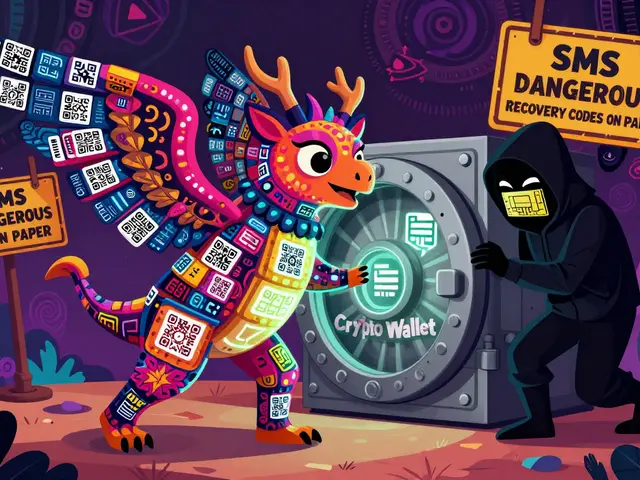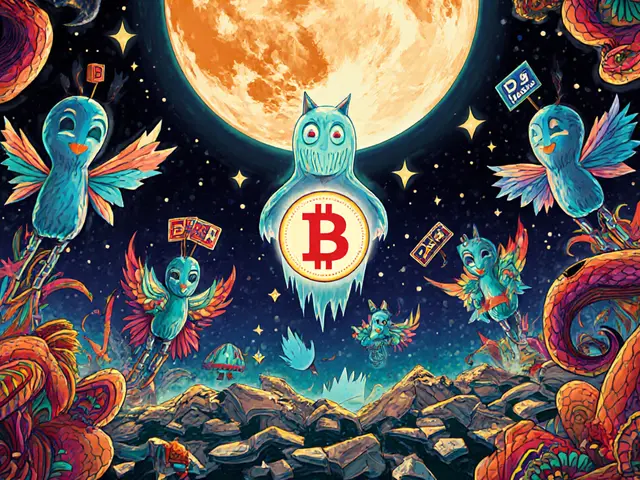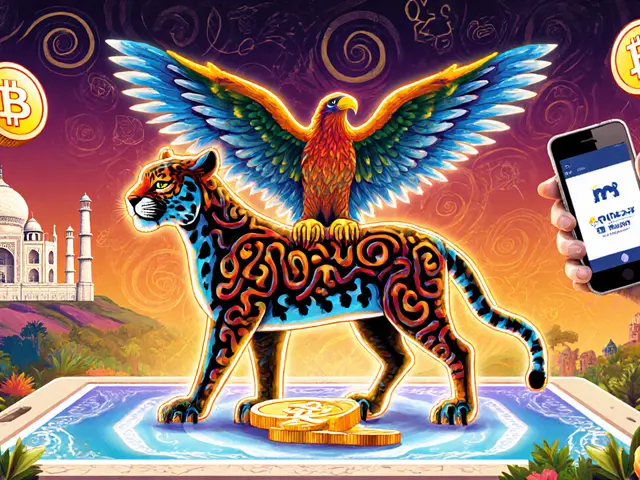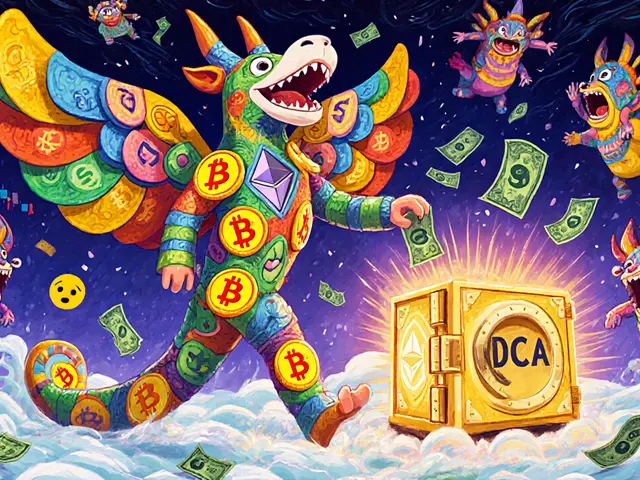Crypto Exchange Comparison Tool
Find the Best Exchange for Your Needs
Important Safety Note
USDT is currently frozen for Iranian users. Always use DAI on Polygon for deposits and withdrawals to avoid freezing issues.
Recommended Exchanges
For millions of Iranians, cryptocurrency isn’t just an investment-it’s a lifeline. With international banking restrictions cutting off access to SWIFT, PayPal, and global payment systems, digital assets have become the primary way people send money, buy goods, and protect savings from inflation. But finding a reliable exchange that actually works for Iranian users isn’t easy. Many platforms claim to accept users from sanctioned countries, but only a handful truly deliver on security, liquidity, and support. Here’s what actually works in 2025.
Nobitex: The Domestic Giant Under Fire
Nobitex handles over 87% of all crypto trades inside Iran. With more than 11 million registered users, it’s the go-to platform for buying Bitcoin, Ethereum, and Tether using Iranian rials. It’s simple, Persian-language support, and integrated bank transfers make it the default choice for most locals.
But things fell apart in June 2025. Hackers stole over $90 million from Nobitex in one of the biggest exchange breaches of the year. The attack exposed deep security flaws-weak wallet controls, poor internal monitoring, and a lack of multi-sig protections. Even worse, blockchain analysts later linked several of the stolen funds to wallets tied to Iran’s Revolutionary Guard Corps. That triggered a crackdown.
In July 2025, Tether froze 42 Iranian-linked addresses, most of which had direct connections to Nobitex. Overnight, USDT became toxic for Iranian users. The government responded by pushing people toward DAI on the Polygon network, a faster, cheaper, and less-monitored stablecoin alternative. Nobitex is still operating, but trust has shattered. Many users are now moving away from centralized domestic exchanges entirely.
International Exchanges That Still Work for Iranians
While domestic options like Nobitex are risky, international platforms offer better security, deeper liquidity, and more coin choices. Here are the top five that Iranian users report still working in late 2025, based on real user feedback and trading data.
MEXC: Best for Low Fees and Wide Selection
MEXC scores 9.1 out of 10 among Iranian traders. It accepts users from Iran without asking for proof of residency. Minimum deposit? Just $30. You get access to 196 cryptocurrencies, including obscure altcoins that aren’t listed on local exchanges. Spot trading fees are 0.2% for makers-among the lowest in the industry. Users appreciate the clean interface and responsive mobile app. Many report successful deposits via peer-to-peer (P2P) USDT transfers from local sellers.
Bitsgap: Best for Automated Trading
Bitsgap doesn’t trade crypto itself-it connects to other exchanges like Binance, KuCoin, and MEXC. That’s a big plus for Iranians: you can automate trades across multiple platforms without needing to hold funds on a single exchange. No minimum deposit. Supports 673 cryptocurrencies. Ideal for users who want to set up grid bots or arbitrage strategies. Fees depend on the connected exchange, but most are under 0.2%. Users say it’s the most reliable tool for active traders avoiding direct exposure to sanctioned platforms.
XT.com: High Coin Count, Solid Reputation
XT.com supports over 1,000 cryptocurrencies-the most of any exchange on this list. Minimum deposit is $10. Maker fees are 0.2%, same as MEXC. It’s been around since 2018 and has never had a major hack. Iranian users report that withdrawals to personal wallets are processed within hours, even during sanctions enforcement waves. The platform doesn’t require proof of address, and Persian-language customer support is available via live chat during business hours.
LATOKEN: Low Entry, High Risk
LATOKEN lets you start with just $1. It supports 475 coins and charges a 0.49% maker fee. The interface is clunky, and customer service can be slow, but it’s one of the few platforms that still allows Iranian users to trade derivatives and futures. Many advanced traders use it for leveraged positions on low-cap tokens. But caution is key-LATOKEN has faced regulatory scrutiny in Europe, and some users report occasional delays in withdrawals during global compliance spikes.
CoinEx: Solid Alternative for Beginners
CoinEx matches LATOKEN on coin count (475) and minimum deposit ($1). Fees are also 0.49%. It’s not the fastest or cheapest, but it’s one of the most stable. The platform offers staking, savings accounts, and a simple copy-trading feature. Iranian users say it’s the most predictable for small traders who just want to buy Bitcoin or Ethereum and hold. Withdrawals are usually processed within 24 hours, even after the July 2025 freezes.

What About KuCoin, BingX, and Others?
KuCoin is often recommended, but in 2025, Iranian users report mixed results. While it has a friendly interface and staking rewards, some accounts have been frozen without warning after deposits from P2P sellers linked to Nobitex. BingX is better for futures trading, but its 4.0/5 rating comes with a caveat: it’s harder to deposit now. Tapbit? Avoid it. Its 2.7/5 rating isn’t a fluke-users report long delays, unresponsive support, and frequent downtime.
The key difference? Platforms like MEXC, XT.com, and Bitsgap have built-in systems to detect high-risk flows. They don’t block Iranian users outright-they monitor for suspicious patterns. If you’re sending large USDT amounts from Nobitex, you’ll get flagged. But if you use P2P to buy DAI on Polygon, then transfer to MEXC, your chances of staying active are much higher.
How Iranian Users Are Adapting
After the July 2025 Tether freezes, Iranian crypto users didn’t give up-they evolved. The shift from USDT to DAI on Polygon was immediate. DAI is decentralized, runs on Ethereum’s Layer 2, and isn’t controlled by a single company. Many now use DEXs like SushiSwap or QuickSwap to swap USDT for DAI, then send it to international exchanges.
Some traders have moved entirely off centralized platforms. They use wallets like MetaMask, connect to DeFi protocols, and earn interest through lending on Aave or Compound. Others use Telegram-based P2P groups to buy crypto directly from sellers in Turkey, Azerbaijan, or the UAE, then transfer to non-sanctioned exchanges.
The Iranian government’s new capital gains tax law (August 2025) also changed the game. For the first time, profits from crypto trades are taxable. That means users now have to track their buys and sells. Many are using tools like Koinly or CoinTracker to log transactions manually. It’s not perfect-but it’s necessary.

What You Need to Know Before You Start
- Never use your real name or address on exchanges that don’t require KYC. Use a pseudonym and a non-Iranian email.
- Use DAI, not USDT for deposits and withdrawals. USDT is still being frozen. DAI is safer.
- Start small. Test withdrawals with $10 before depositing larger amounts.
- Enable 2FA and never share recovery phrases. Iranian users have been targeted by phishing scams using fake Nobitex login pages.
- Use a VPN only if the exchange blocks Iranian IPs. Some platforms like MEXC don’t block them, so a VPN isn’t needed and can trigger extra scrutiny.
The Bottom Line
Iranian citizens can still trade crypto in 2025-but the landscape is more dangerous than ever. Nobitex is broken. USDT is risky. But alternatives exist. MEXC, Bitsgap, and XT.com are currently the most reliable for international access. DAI on Polygon is the new backbone of the Iranian crypto economy. And while the government is now taxing gains, the need for financial freedom hasn’t disappeared.
If you’re in Iran and want to use crypto, don’t rely on domestic exchanges anymore. Don’t trust USDT. Don’t assume big names like Binance or Coinbase will work-they don’t. Stick to the platforms that have proven they still let Iranians trade, even under pressure. The tools are there. The access still exists. But you need to be smarter, more cautious, and more adaptable than ever before.
Can Iranian citizens use Binance or Coinbase?
No. Binance and Coinbase officially block users from Iran due to U.S. sanctions. Even if you try to sign up with a VPN, your account will likely be frozen or restricted. These platforms have strict compliance systems that flag Iranian IPs and banking details. Stick to exchanges that don’t require KYC or have a track record of serving Iranian users, like MEXC or XT.com.
Is it legal to use crypto in Iran?
Yes, but with conditions. The Iranian government allows citizens to buy, sell, and hold cryptocurrency for personal use. However, mining is heavily regulated, and trading for profit is now subject to capital gains tax under the August 2025 law. You can’t use crypto to pay for international goods or send money abroad through exchanges-that’s still illegal. But holding and trading domestically is tolerated, even if not fully endorsed.
Why is USDT being frozen for Iranian users?
Tether, the company behind USDT, froze 42 Iranian-linked addresses in July 2025 after identifying connections to Nobitex and IRGC-affiliated wallets. USDT is a centralized stablecoin, meaning Tether can freeze funds at the request of regulators. After the Nobitex hack, blockchain analysts found that many stolen funds flowed through wallets tied to sanctioned entities. To avoid legal liability, Tether acted aggressively. That’s why Iranian users are now switching to DAI, which is decentralized and can’t be frozen.
Which exchange has the lowest minimum deposit for Iranians?
Bitsgap has no minimum deposit requirement. LATOKEN and CoinEx allow deposits as low as $1. MEXC requires $30, and XT.com requires $10. If you’re starting with very little, Bitsgap is your best option because it connects to other exchanges-you don’t need to deposit directly into Bitsgap itself. You can fund your connected exchange (like MEXC) with $1 and use Bitsgap to automate trades.
Can I withdraw crypto from these exchanges to my personal wallet?
Yes, but be careful. Most exchanges on this list allow withdrawals to personal wallets like MetaMask or Trust Wallet. However, withdrawals of USDT are risky-many are being flagged or frozen. Always withdraw to DAI on Polygon or ETH directly. Avoid sending large amounts at once. Test with small withdrawals first. Also, make sure your wallet address isn’t linked to Nobitex or any other sanctioned exchange.











20 Comments
Bro, MEXC is the GOAT 🚀 I bought my first 0.002 BTC with $30 and now I’m laughing all the way to the DAI bank. Nobitex? More like Nobitex-its-our-money-now 😂
This is such a lifeline for so many people. I can’t imagine living under these kinds of restrictions. The shift to DAI on Polygon is genius-decentralized, unstoppable, and honestly, kind of beautiful in its resilience.
I told u all this would happen. The US gov’t is just letting Tether do their dirty work. They froze USDT to scare Iranians into using DAI so they can track them better. It’s all a trap. 🕵️♂️
There’s a quiet poetry in how people adapt. When the system tries to lock you out, you don’t rage-you rewire. DAI isn’t just a stablecoin. It’s a silent rebellion written in smart contracts. And the fact that Iranians are using Telegram P2P to bypass sanctions? That’s human ingenuity at its most elegant.
Man, I’ve been following this since last year. When Nobitex got hacked, I thought it was the end-but no. People just got smarter. Started using DAI, moved to MEXC, learned how to use Bitsgap for bots. It’s like watching a whole economy rebuild itself from ashes. Honestly? I’m inspired. We don’t need big banks. We just need each other.
Y’all are doing AMAZING. Seriously. This is the kind of resilience I wish more people saw. Crypto isn’t just about making money-it’s about freedom. And Iranians are showing the world how to fight for it without a gun. I’m sending love and DAI your way 💪❤️
I’ve helped a few Iranian friends set up wallets over the last year. The most common mistake? Using their real name on non-KYC exchanges. Don’t. Ever. Use a throwaway email, a random username, and never reuse addresses. One slip and your whole stack gets flagged. It’s not paranoia-it’s survival.
I just want to say thank you to everyone in Iran who’s still trading, still learning, still holding on. You’re not just surviving-you’re building a new financial future. And you’re doing it quietly, without fanfare. That’s the real crypto spirit. 🙏
Funny how the same people who scream about ‘financial freedom’ when it’s Wall Street suddenly get quiet when it’s Iranians using DAI. The hypocrisy is thicker than a 1000x memecoin rugpull.
The institutionalization of DAI on Polygon is a paradigm shift. The convergence of DeFi primitives, Layer-2 scalability, and decentralized governance has effectively neutralized the hegemony of centralized stablecoins in sanctioned economies. Tether’s centralized control mechanism is an anachronism-now rendered obsolete by atomic swaps and non-custodial wallets. This isn’t just adoption. It’s systemic evolution.
I dont know why people are so surprised. The moment any asset becomes a tool for resistance its going to get targeted. USDT was always going to be weaponized. DAI was always the answer. The real question is why it took so long for the world to notice that Iranians were already building the future.
I’m a teacher and I’ve shared this with my students. It’s not just about crypto-it’s about economics, geopolitics, and human creativity. We’re looking at a real-time case study of how oppressed communities innovate under pressure. This is textbook material now.
I used to think MEXC was sketchy but after seeing how many Iranians use it daily and still get withdrawals? I switched too. $30 in, DAI out, no drama. Best $30 I ever spent.
If you’re new to this, start with CoinEx. It’s slow but reliable. Don’t chase speed. Chase consistency. Withdraw $10 first. Wait 24 hours. Then go bigger. Patience saves portfolios.
I’ve been quietly using Bitsgap for 8 months. It’s not flashy, but it’s the most reliable bridge I’ve found. Connects to MEXC, XT.com, KuCoin when it works. I never hold on the exchange. Just trade and move. Simple.
I tried to send $50 to Nobitex last week. Got flagged within 2 hours. Then I bought DAI on QuickSwap, sent it to MEXC, and withdrew to my wallet. Took 17 minutes. That’s the difference between a dying system and a living one.
They’re all lying. The government knows about DAI. They’re letting it fly so they can monitor every single transaction. Every swap, every transfer-it’s all being logged. This isn’t freedom. It’s surveillance with better UX.
I’m from India and I’ve sent DAI to Iranian friends through Telegram P2P. No KYC. No questions. Just trust. And yeah, it works. People think crypto is about speculation. Nah. It’s about solidarity.
Nobitex was a dumpster fire from day one. But the real story? The fact that Iranians didn’t panic. They just switched to DAI and kept going. That’s not crypto. That’s civilization.
DAI on Polygon? So 2024. I’m already using USDC on Arbitrum with a Turkish P2P seller. Faster, cheaper, and Tether can’t touch it. Y’all are late to the party. 😴